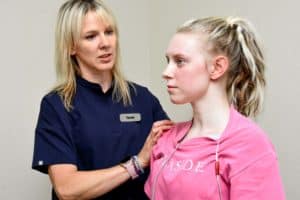Management of Individuals With Multiple Chronic Conditions
Because CRPS is so painful, patients who suffer from it will mostly pay little attention to any other symptoms or health conditions they may be suffering from, in my experience. CRPS is like a blinding white light, obliterating anything else. I have often said that severe chronic pain will cause almost a numbing effect in the person who suffers from it. I have dubbed this a “pain callous”. Patients who suffer from CRPS experience pain differently from other people. I always tell my patients that I’m a great example. The closest to your misery that I have ever felt was natural childbirth, which had an end. If I get the smallest headache (which happens maybe once a year), I will easily rate it at a seven to eight out of ten. I’m a wuss when it comes to pain! The average CRPS patient will barely blink at even a migraine. I believe that this phenomenon is not yet clearly understood, but that the body adapts to pain to some extent in order to survive, or it would drive you to insanity.
Once the CRPS patient recovers, their pain response will return to normal also, and do so rapidly. While this is often experienced as a loss by CRPS patients in my experience, it is vastly important to once again experience pain normally. Why? Your body uses pain and symptoms as an alarm system. If your brain cannot ‘hear’ the alarm, it cannot be alerted to the problem. While you are suffering from CRPS, and you have this ‘super power’ that allows your brain to ignore pain and other symptoms that simply cannot compete with the raging pain of CRPS, you may not pay attention to what is commonly referred to as “concurrent’ conditions, which are conditions you suffer from in addition to CRPS. These conditions may also harm your health, and definitely deserve your attention.
When you go to your doctor, these conditions may be addressed, but typically they will be treated as separate and often unrelated to CRPS. However, remember: your body is a whole, not an engine made of separate parts. Every part affects every other part. Because of the complexity of the nervous system dysfunction responsible for CRPS, the patient will often suffer from other conditions and symptoms also related to the same nervous system dysfunction. Because your health is precious, it is important to understand what these conditions may be, so that the underlying cause may be addressed. Please understand that this topic alone could fill a book. Therefore, I cannot possibly touch on every single condition that may be related. I will attempt to cover all the big ones, though.
Allergies
Patients who suffer from autonomic dysfunction (all CRPS patients) will usually also suffer from autoimmune dysfunction. The immune system is directly governed by the autonomic nervous system, and cannot function properly without it. Autoimmune dysfunction will usually eventually lead to autoimmune conditions, one of which is allergies. This causes a vicious cycle, as the more things you become allergic to, the more these foods or substances will cause inflammation when you consume them or are exposed to them. The vast majority of my CRPS patients will actually test allergic to their own body fluids, such as blood, saliva and urine. Patients may even become allergic to their own sperm or vaginal fluid, or that of their partner. This will often result in unexplained infertility. It is foolish to treat the allergies, without first treating the autoimmune component, and in turn, the autonomic dysfunction underneath it all.
Chronic Fatigue Syndrome
As you may guess, the name of this syndrome says it all. When you suffer from this you are chronically, debilitatingly tired, and no readily apparent underlying medical cause can be found. Sleep becomes an obsession, but in a cruel twist, does not relieve your fatigue. This syndrome is usually only considered to be an “official” diagnosis once you have been fatigued for six consecutive months or more. It is often missed in CRPS patients because severe pain usually affects the quality and quantity of your sleep anyway.
CFS patients may also suffer from headaches, a weakened immune system, depression, increased sensitivity to light, sounds, and smells, digestive issues, and possible cardiac problems (all of which symptoms are also often found in those who suffer from CRPS). Physical or mental stress may make this syndrome worse. Patients who suffer from this should have both their adrenal and thyroid function thoroughly tested.
It is my belief that an unbalanced autonomic nervous system is responsible for the majority of cases of chronic fatigue syndrome, as the parasympathetic (resting and digesting) system is turned off and the sympathetic (fight or flight) systems are “on” all the time. Adrenal support and supplementation are crucial for these patients, as is balancing the autonomic nervous system so that the parasympathetic nervous system is turned back on.
Digestive Disorders
Because of the Vagus nerve malfunction, CRPS patients almost universally will exhibit some form of GI symptoms and/or conditions. These symptoms may be as mild as constipation or as severe as gastroparesis, a complete shutdown of the GI system. Other diagnoses may include IBS (Irritable Bowel Syndrome), Diverticulitis, Celiac Disease, Crohn’s Disease and Gluten Intolerance, to name but a few.
In my experience, few doctors will treat these problems as a central nervous system dysfunction. It is far more likely that these patients will be prescribed medicine to counteract their symptoms. If they experience heartburn, they will be given antacids. If they are constipated, they will be prescribed medication for that. Of course, this complicates the toxic load your GI system is already dealing with, not to mention your liver and kidneys.
The following may cause digestive symptoms (especially in patients suffering from CRPS):
- Autonomic (parasympathetic) nervous system dysfunction, turning “off” digestion and the immune system in the gut, specifically malfunction of the Vagus nerve
- Overuse of antibiotics causing an imbalance in good vs. bad bacteria
- Candida overgrowth resulting from a weakened immune system, heavy metal toxicity, or not enough good bacteria in the gut
- A poor diet low in fiber, acidic in nature, and high in sugar and saturated fats
- Medications adversely affecting the gut
- Weakened digestive enzymes, resulting in food not being completely digested
- Food sensitivities or allergies
The health of your digestive system is directly linked to the health of your immune system. Almost 70 percent of the immune system resides in your intestinal tract.29 This branch of the immune system, made up of billions of friendly bacteria and yeast, is responsible for many functions including proper nutrient absorption, production of vital nutrients (produced by the bacteria in your gut), detoxification and alkalization of the body, and last but not least, one of the main weapons your body uses in fighting against bad bacteria.
While we do not have the luxury of space to discuss every digestive problem or diagnosis in detail, we feel strongly that the digestive system of every patient suffering from fibromyalgia must be treated as if it is not well.
The Basic Steps Necessary to Heal the Digestive System:
- Detoxify
- Avoid foods that you are allergic to (or get treated for your specific allergies)
- Change your diet
- Rebuild the gut with good food and good bacteria
- Nourish the body with healthy and proper vitamins, minerals and supplements
Every patient who suffers from CRPS should rebuild and restore their digestive system.
Fibromyalgia
Fibromyalgia is a condition that causes the patient to experience chronic pain affecting the entire body that may ‘jump’ from area to area, along with severe, chronic fatigue. Patients who suffer from Fibromyalgia often will report that they suffered from some type of old cervical or tailbone injury, such as whiplash or falls. Like CRPS, fibromyalgia is neurologic pain. There is actually much overlap between these two conditions, although the pain experienced by CRPS patients is much more intense in nature than that associated with fibromyalgia. CRPS usually confined to one area, unless it spreads. It is possible, and in fact not uncommon, to suffer from both conditions at the same time.
Rheumatoid Arthritis (RA)
The Vagus nerve is responsible for inhibition of pro-inflammatory cytokines. It has been found that implanting a device that stimulates the Vagus nerve often reverse the symptoms of RA within a very short period of time. Again, it seems that the Vagus nerve falling down on the job is implicated. For this reason, many patients who suffer from RA may develop CRPS or vice versa. RA causes pain in the feet and hands and other joints in the body, and may deform those joints over time. RA is usually symmetric, unlike Osteo Arthritis, which may only affect a joint on one side, and results from wear and tear or old injuries. RA is an inflammatory autoimmune disease where your own body mistakenly attack itself. It usually begins after age forty, but may affect even younger people. My CRPS patients who respond well to treatment often notice a dramatic change to their RA as well.
Post Traumatic Stress Disorder (PTSD)
Once called shell shock, PTSD is a serious condition that can develop after a person has experienced or witnessed a traumatic or terrifying event in which serious physical harm occurred or was threatened. PTSD is a lasting result of a traumatic experience that caused intense fear, helplessness, or horror, such as a sexual or physical assault, the unexpected death of a loved one, or an accident, war, or natural disaster.
Most people who experience a traumatic event will have reactions that may include shock, anger, nervousness, fear, and even guilt. These reactions are common, and for most people they go away over time. However, for a person with PTSD, these feelings continue and may even increase, becoming so strong that they keep the person from living a normal, happy life. People with PTSD have symptoms for longer than one month and cannot function as well as they did before the event occurred.
Patients who suffered sexual or physical abuse suffer from a high burden of stress upon their nervous systems and bodies, affecting the autonomic nervous system (as one perpetually lives in a state of fight or flight) and are much more likely to develop chronic conditions such as CRPS. Inversely, because of the trauma associated with suffering from high levels of daily pain, CRPS patients may sometimes develop PTSD because they suffer from CRPS.
Multiple Sclerosis
Multiple sclerosis (MS) is a chronic, often disabling disease that was previously thought to be caused when the body’s immune system attacks its own central nervous system (CNS), resulting in the myelin sheaths (think of them as insulation around electrical wires) around nerve cells in parts of the brain and spinal cord being damaged, in turn leading to loss of myelin and scarring. These changes affect the ability of nerve cells to communicate, resulting in a wide range of signs and symptoms. These symptoms may be mild, such as numbness in the limbs, or severe, such as loss of vision or paralysis.
The progress, severity, and specific symptoms of MS are somewhat unpredictable and may vary from one person to another. Typical symptoms may include fatigue, loss of vision/hearing, double vision or visual blurriness in the central visual field that affects only one eye, weakness of the arms or legs, neuropathy (tingling, pain or numbness) in the limbs, speech impairment, difficulty balancing, and bowel or bladder incontinence.
A diagnosis is often made after a careful history and neurological exam (the skills of the neurologist are crucial here), a spinal tap, blood tests (to rule out conditions with similar symptoms), MRI (to show lesions), and a neurological test called an evoked potential test (to show nerve damage).
The model for immune system dysfunction leaves one obvious question unanswered: why does the immune system turn on itself in the first place? After all, this seems to be a common occurrence in multiple conditions including MS, fibromyalgia, lupus, and rheumatoid arthritis. All share an immune system gone haywire and now on the prowl, damaging its own body. Since the immune system is governed by the Central Nervous System, it would make sense that there might be a link between this system and the immune system’s nutty behavior.
A groundbreaking study performed in 2011 using upright MRIs found: “Multiple sclerosis may be bio-mechanical in origin wherein traumatic injuries to the cervical spine result in cervical pathologies that impede the normal circulation of CSF to and from the brain.“30 In layman’s terms, this means that multiple sclerosis may also be caused by injuries to the cervical spine, such as car accidents. While more studies are needed, we find this research eye-opening and very promising indeed. In our work, we have noticed great changes in the neurological symptoms of MS when the upper cervical spine was treated and corrected.
Lyme Disease
If you have Lyme disease, or know someone with Lyme disease, hang on to your chair, as we are about to give you a whole new look at this disease.
The most accepted and universal belief is that Lyme disease (Lyme Borreliosis) is an infectious tick-borne disease caused by at least three species of bacteria belonging to the genus Borrelia. Early symptoms may include fever, fatigue, headaches, or depression. A characteristic circular skin rash called erythema migrans (EM) appears around the bite. Left untreated, later symptoms may involve the heart, joints, and central nervous system. In most cases, the symptoms are eliminated by antibiotics, if treated early. However, delayed or inadequate treatment can lead to more serious symptoms, which may be disabling and difficult to treat.
Lyme disease is divided into three stages. First is early localized infection, where the infection has not yet spread throughout the entire body. During this stage, roughly 80 percent of patients will develop the characteristic “bulls-eye” rash at the site of the bite. The second stage is the early disseminated infection, when the infection spreads through the bloodstream within days to weeks after the onset of the initial local infection. This happens in only one in three hundred to four hundred cases, where again only 10 to 15 percent of patients may subsequently develop neurological symptoms such as meningitis (an infection of the membranes around the brain and spinal cord), shooting pains, and palsy of the face (where the muscles in the face become paralyzed).
Late disseminated infection (stage III) may occur after several months, when a small percentage of patients (about 5 percent) go on to develop severe and chronic symptoms that affect many parts of the body. This may include the brain, nerves, eyes, joints, and heart. Other serious symptoms may include “frank” psychosis, arthritis, vertigo, and bladder problems.
The current theory about Lyme Borreliosis was formulated in 1977. At that time, Allen C. Steere, MD, and his colleagues, who were studying rheumatology at Yale University (he is now a professor at Harvard), discovered a “new disease” called Lyme Borreliosis after substantial prospective trials. In 1983, the first international conference on Lyme disease took place at Yale University. However, in 2012, Dr. Steere stated that long-term symptoms seen in Lyme disease were, in his opinion, caused more by an immune system failure rather than an infection, and would not benefit from antibiotics.
The problem with the current Lyme disease theory is that not all people bitten by an infected tick become sick with Lyme disease. Therefore, it stands to reason that the immunity of the host must have something to do with it, and all the problems can’t be caused by bacteria alone (we come full circle, once again back to the immune system). It follows then that part of a well-rounded treatment program should be to strengthen the body and immune system from the inside.
Treatment steps for Lyme disease
It is our opinion that unless the infection is less than two weeks old, it should not be treated with antibiotics. Please find a health care practitioner knowledgeable in Lyme disease who can guide you through the following treatment steps:
- Get tested for heavy metal toxicity.
- Detoxify your body of all toxins.
- Improve the overall health of your body with diet, supplementation, and specific treatments aimed toward improving the immune system.
Lab testing will rule in or rule out Lyme disease in most cases.
Tests include the Borrelia-DNA via PCR (polymerase chain reaction), which may be used to diagnose an acute infection in the first few weeks, but has proven to be rather inaccurate after that. If a suspected infection is older, an enzyme-linked immunoassay (ELISA) test to look for IgG and IgM antibodies (which may give false negatives early on) or a Western blot test may be used.
Interstitial Cystitis (CS)
Interstitial cystitis (IC) or painful bladder syndrome (PBS) is a chronic inflammation of the bladder wall that causes nagging pain and severe discomfort. Symptoms often include a sense of urgency and increased frequency of urination. While a healthy adult urinates on average about six times a day, a person with IC may urinate up to seventy times in twenty-four hours, including several times at night, interrupting their sleep.
Inflammation associated with IC causes the lining to scar and the bladder to become stiff and less elastic, which may affect the way the bladder can expand. In about 90 percent of IC cases, there are pinpoint spots of bleeding visible in the lining. In up to 10 percent of cases, ulcers known as Hunner’s patches may form on the bladder wall. As if this condition isn’t uncomfortable enough, it may also worsen during menstruation and can cause intercourse to be painful for both sexes.
A large survey of six thousand seven hundred and eighty-three patients with IC/PBS found that 40 percent of patients with IC also suffered from allergies, while 30 percent suffered from irritable bowel syndrome.
Cranberry extract (not juice) has proven to be somewhat successful, as well as a supplement called D-mannose. D-mannose is a type of sugar that has been shown to relieve IC/PBS. It is theorized that D-mannose might treat the deficiency caused by a genetic defect that causes abnormal breakdown and production of mannose or that D-mannose might prevent certain kinds of bacteria from sticking to the walls of the urinary tract and causing infection. (This supplement can be ordered at mercola.com.)
Interestingly enough, as if following a trail of breadcrumbs, the newest research again points to the autonomic nervous system as a direct cause of IC/PBS, where it is shown that people with IC/PBS also exhibit an overactive sympathetic nervous system.31
Trigeminal Neuralgia
Trigeminal neuralgia (also known as tic douloureux) is a nerve disorder that causes sharp, sudden, searing, electric-shock-like facial pains and affects about one out of every fifteen thousand people, although it is much more common among those who also suffer from CRPS. The pain comes from a cranial nerve called the trigeminal nerve and usually affects one side of the lower face and jaw, although symptoms may appear near the eyes, ears, nose, jaw, or lips. Many experts say trigeminal neuralgia is the most unbearably painful human condition, and for this reason, it is tragically also known as “the suicide disease.”
Trigeminal neuralgia has been linked with autonomic nervous system dysfunction.32 In addition, at least one study has linked it to upper cervical trauma such as whiplash injuries.33 Medically, this condition is treated with medications or surgery. We believe that this condition must be approached in such a way that the autonomic nervous system dysfunction is balanced and corrected. In addition, we correct any upper cervical misalignment present and rehabilitate the trigeminal nerve in our treatment approach.
Restless Leg Syndrome
Restless leg syndrome (RLS) is a neurological disorder characterized by unpleasant sensations in the legs (and sometimes other parts of the body such as arms, trunk, or head), and an uncontrollable or overwhelming urge to move them. People with RLS may constantly move their legs (or other affected parts) to minimize or prevent these sensations.
Symptoms may include throbbing or a pulling and crawling sensation occurring primarily at night. Resting or lying down actually worsens these sensations, making it particularly disruptive to sleep and rest. The sensations range in severity from uncomfortable to irritating to painful. RLS is very common and may affect up to 10 percent of the population, especially the CRPS population. Medically, this condition is usually addressed through medications. At least one study has found a definitive link between sympathetic nervous system dysfunction and RLS.34
Ehlers- Danlos Syndrome
Ehlers-Danlos syndrome is a group of disorders that affect the connective tissues that support the skin, bones, blood vessels, and many other organs and tissues. Abnormalities in connective tissues cause the signs and symptoms of Ehlers-Danlos syndrome, which vary from mildly loose joints or hypermobile joints to life-threatening complications.
People who have Ehlers-Danlos syndrome usually have overly flexible joints and stretchy, fragile skin. A more severe form of the disorder, called vascular Ehlers-Danlos syndrome, can cause the walls of your blood vessels, intestines or uterus to rupture. Because this syndrome may affect the Internal Jugular Vein, causing it to take up more space in the carotid sheath, it may put pressure on the Vagus nerve, resulting in autonomic dysfunction leading to CRPS.
Postural Orthostatic Tachycardia Syndrome (POTS)
When a patient’s heart rate speeds up 30 beats per minute or more without much change in blood pressure on standing, the patient may have POTS. POTS is most frequently seen in young women, often less than 35 years of age. The increase in heart rate is usually a sign that the cardiovascular system is working extra hard to maintain blood pressure as well as blood flow to the brain.
Typical signs and symptoms of POTS include (but may not be limited to); Profuse and sudden sweating, headaches of a throbbing quality, fainting, nausea, shortness of breath, exhaustion, chest pain, weakness, and visual changes. Once again, POTS is caused by an abnormally functioning autonomic nervous system, specifically indicating the Vagus nerve. Often, the patient will report a viral infection shortly before the development of their symptoms. Remember, viral infections may directly inflame the Vagus nerve.
Vulvodynia
Vulvodynia is unexplained pain in the vulvar area (external female private part) and/or vagina, that can last for years. The pain that is its hallmark has been described as sharp, burning, rawness or stinging, much like dozens of tiny paper cuts in your private parts (yikes!). It affects approximately 16% of all females at some point and is therefore considered to be quite common. It is often made much worse by touch or indirect contact, making intercourse and wearing tampons darn near impossible. Traditional treatments are varied and typically not spectacularly successful. Once again, inflammation of the nervous system seems to be linked to this condition35, and stimulation of the Vagus nerve seems to have a very positive effect on this condition36.
Weird Chest Pain
CRPS patients often suffer from atypical chest pain, which is more frequent in females than males, The cause of this is irritation and sensitization of the intercostobrachial (ICB) nerve. This nerve originates from the second intercostal nerve root (T2, or second Thoracic vertebra) bilaterally from the spine and also has input from the T3 and T4 nerve roots. It supplies the axilla (underarm area), medial and anterior arm, and contributes to the innervation of the chest wall in the upper front area. It also contributes to the nerve supply of the back of the forearm and occasionally also the Pectoralis Major and Minor muscles.
Changes To Your Brain
Studies have shown that patients who suffer from CRPS show clear changes to the brain37. These changes included atrophy (or shrinking) of the gray matter (outside of the brain) and connectivity in the white matter (inside of the brain). The areas affected result in changes to the intensity and duration of pain, two things that CRPS patients can scantly afford. The changes in the brains and Central Nervous Systems of CRPS patients may affect them in other ways, too. Severe neuropathic chronic pain has been shown to be associated with poor performance on neuropsychological tests that assess working memory, language and executive function.
While the above list is not all- inclusive, it covers many of the other symptoms that CRPS may suffer from. Keep in mind that an abnormal Autonomic Nervous System (ANS) may affect all kinds of other systems in the body. Whatever you suffer from, always try to trace it back to the Central Nervous System, thinking about your symptoms in a logical way, instead of just allowing your doctor to treat the symptom with a drug.
Complex Regional Pain Syndrome Treatment Center – The Spero Clinic
The Spero Clinic focuses on treating the pain as a whole and has successfully helped CRPS patients enter remission. We don’t use opioids and refuse to mask the pain. Our goal has been and will always be to use non-invasive treatment methods to help patients lead pain-free life. Contact us today.







